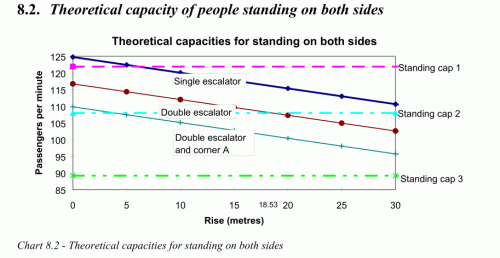News abounds that London Underground is encouraging people to stand on both sides of the escalator.
Holborn tube station is testing the idea, with staff exhorting people to stand on both sides of the escalators to see if it can increase throughput of passengers leaving the station.
Peter McNaught, Operations Director for the Central line, said that “as part of a three-week trial to reduce queues and keep people moving through the station, we are encouraging customers to stand on both sides of the ‘up’ escalators during busy periods.”
“We believe this will increase the capacity of the escalators as more people will be able to board, preventing queuing at the bottom of the escalator.”
Now, as it happens, there’s science behind this, and that science is based on a study of encouraging people to stand on both sides — carried out in 2002, also at Holborn station.
Paul Davis of the London School of Economics and Political Sciences and Goutam Dutta of the Indian Institute of Management wrote a report on the capacity of escalators on the London Underground.
What they found was, that for a double escalator with a rise greater than about 18.5 metres, theory said that capacity would be greater if people could be encouraged to stand on both sides.
The question was whether theory and reality converged.
So, in 2002, the authors asked Holborn station to test the theory.
Unsurprisingly, the results are mixed, basically, because the great majority of people paid no attention to the customer announcement. It does after all sound a bit odd and counterintuitive.
On the two occasions when passengers were standing on both sides, they found that the standing side had nearly 50 passengers per minutes, whole the “walking” side averaged nearly 76 passengers per minute.
The increased capacity was more due to the walking side constantly shuffling forwards as people felt the need to walk and preferred to tut at people who stood.
Sadly, the report concluded that the 2002 experiment at Holborn was not successful in indicating what the capacity of an escalator would be if passengers were persuaded to stand on both sides for anything more than short periods of time.
Which brings us back to 2015, and time for another experiment.
Will be interesting to see the results in a few weeks time.
The report, Estimation of Capacity of Escalators in London Underground is available here.









Surely the gap that opens up if someone does stand on the walking side suggests that walking is better? All the arguments about % occupancy per tread and higher turbulence are irrelevant in light of this observation.
When I visited St Petersburg where the metro is particularly deep all the up escalators had people standing on both sides while the down escalators matched the London practice. Anecdotally the escalators just seemed too long for anyone to want to walk up.
I can’t believe stand+stand is faster than walk+stand.
However, I would test it in vitro where participants stick to the rules.
For example in Holborn station at night when the station is closed, with a few hundred people. The theory could be confirmed or busted in ten minutes.
I think the real issue being addressed is the congestion caused by people queueing to use the standing side when the walking side is free (so broadly relevant only if the majority want to stand). Let them step on to either side and the total input to the escalator goes up. As in extreme cases it can be difficult to squeeze through the queue to walk up anyway perhaps overall it even benefits those of us who would walk.
Perhaps it all needs to be fuzzier than we English could handle; stand on the right unless there’s a queue, in which case stand either side.
Also this seems to only apply to long escalators, so there would need to be signs regarding how long this escalator was so you knew when to stand on both sides.
What about stations where there’s two escalators going up? Maybe one can be standing both sides, and the other standing/walking split.
In theory, practise and theory are the same.
In practise, they’re not.